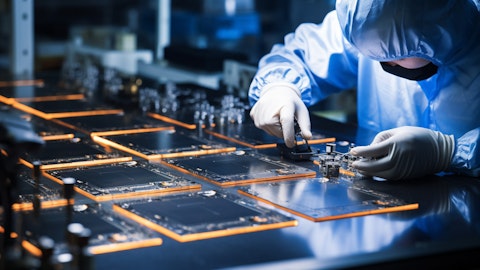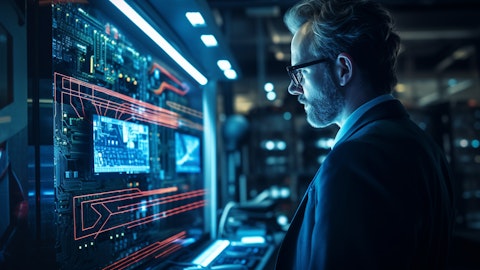We recently compiled a list of the 15 Best Data Center Stocks To Buy According to Jefferies, Citi and Wall Street Analysts. In this article, we are going to take a look at where IHS Holding Limited (NYSE:IHS) stands against the other data center stocks.
The boom in the interest surrounding artificial intelligence has not only affected semiconductor stocks, even though they’re the biggest beneficiaries. While the chips that these companies make are indispensable for running AI workloads, they have to be housed somewhere, and this is where data centers come into play.
In fact, for the data center space, AI has only accelerated the growing demand this industry is seeing. Prior to AI GPUs and accelerators, enterprise computing chips made by the same companies that are now making AI chips were seeing hefty demand. This demand led to gaming GPU companies effectively being transformed into enterprise computing firms, with sectors such as the SaaS and cloud computing industries relying on these products. For some SaaS stocks, you should check out 10 Best SaaS Stocks To Buy Now.
This pre AI demand for data centers is visible in statistics too. Data from Jefferies shows that the demand growth for data centers has jumped by between 10% to 20% for the last 15 years, or before AI GPUs hit the market. As expected, AI has accelerated this demand, with the demand for data center space outpacing 30% in most markets for the past two years. This growth in real estate requirements also means that while the computing industry might be able to scale up by providing products like networking gear and cables, tertiary industries like energy generation will take some time to catch up.
If you’re a believer in AI, then the optimistic line of thought would suggest that these tertiary firms will only grow in the future as they scale up their operations to meet the growth in AI data centers. After all, data from Goldman shows that a query made to ChatGPT consumes ten times as much energy as a Google search query – understandable since ChatGPT is parsing through data and drawing insights to generate a response. By 2030, AI is expected to grow data center power demand by as much as 160%, as data centers potentially account for 4% of global energy consumption and Europe in particular needs more than $1 trillion to power its AI grid.
Naturally, since the US is responsible for ushering in AI, AI energy consumption in America is higher than that in other countries. According to the Boston Consulting Group, by 2030, AI power consumption will account for 16% of all of America’s energy use. It is expected to grow by 15% to 20% annually and touch as much as 130 GW, or the amount of electricity that’s used by 100 million homes. AI chip companies are also aware of these trends, with the latest AI chips promising to improve energy efficiency by 25x. Improving AI performance at the semiconductor level is important especially since some areas where data centers are growing are being forced to turn to coal power to reduce the power gap.
Nowhere is this clearer than in Northern Virginia, where data centers process 70% of the world’s internet traffic. With more than 300 data centers that churn out more than $700 million in taxes annually, the region’s computing centers are expected to require a whopping 11,000 megawatts of electricity annually by 2035 according to estimates by the local regulator. This demand has also spurred a $5.2 billion effort to lay down new transmission lines and keep coal power plants open for longer than initially planned.
Not only does AI need real estate and power, but it also needs water. Since energy can neither be created nor destroyed, all the megawatts of power that AI chips need have to go somewhere. For the chips, it is dissipated in the form of heat, and cooling this requires copious amounts of water. Estimates show that not only does training GPT-3 evaporate a whopping 700,000 liters of drinkable water, but global AI demand by 2027 could end up using anywhere between 4.2 billion to 6.6 billion cubic meters of water.
Coming back to real estate, it might be the easiest way for the AI savvy investor to cash in on the world’s thirst for computing. Citi believes that the “development and construction of hyper-scale data center capacity will grow meaningfully over the next 7 years,” as global industrial giants expand into the data center space. Not only are industrial firms actually converting their warehouses into data centers, but Citi adds that the associated power demand for these computing facilities will grow between the mid teens annually until 2030.
So, as these Wall Street firms lay out a maze of industries that will profit from AI, we decided to look at the top data center stocks to buy according to analysts.
Our Methodology
To make our list of the top data center stocks to buy, we ranked the US listed holdings of Global X’s data center ETF and the stocks chosen by Jefferies and Citi by the average analyst share price target percentage upside and picked out the stocks with the highest upside.
For these stocks, we also mentioned the number of hedge funds that had bought the shares in Q1 2024. Why are we interested in the stocks that hedge funds pile into? The reason is simple: our research has shown that we can outperform the market by imitating the top stock picks of the best hedge funds. Our quarterly newsletter’s strategy selects 14 small-cap and large-cap stocks every quarter and has returned 275% since May 2014, beating its benchmark by 150 percentage points (see more details here).

20 Largest Telecom Companies in The World by Revenue
IHS Holding Limited (NYSE:IHS)
Average Analyst Share Price Target Upside: 217%
Average Analyst Share Price Target: $8.40
Number of Hedge Fund Investors in Q1 2024: 10
IHS Holding Limited (NYSE:IHS) is a Britain based communications infrastructure firm with facilities in Africa, Latin America, and the Middle East. Citi last covered its shares in May 2024, when it kept a $3.70 share price target and a Buy rating for the shares. The target was cut from $8 in February due to IHS Holding Limited (NYSE:IHS)’s over exposure to Nigeria and the devaluation of that country’s currency which means that the firm’s revenue to US investors dropped. The bank stressed in February that IHS Holding Limited (NYSE:IHS) needs to formulate a value creation particularly due to the high risk of customer churn. Like APLD, IHS Holding Limited (NYSE:IHS) is also divesting some of its business units to generate cash, and this can lead to as much as $1 billion in proceeds for the firm. During Q1, the firm added 270 new tenants and expanded its communications footprint in the highly lucrative market of Brazil.
As for its value creation plan, here’s what IHS Holding Limited (NYSE:IHS)’s management shared during its Q1 2024 earnings call:
“We continue to look at all options through a value-creation lens with the goal of maximizing the value of our assets and therefore value for shareholders over the near, medium and long term.
There are a number of areas of focus here. One, increasing our operating profitability and substantially reducing our CapEx to increase cash flow generation, which is reflected in our 2024 guidance and implies a notable step-up in adjusted EBITDA margins for the remainder of the year and a significant reduction in CapEx year-over-year. Two, we continue to review our portfolio of markets to determine the right composition for IHS going forward. This is expected to include the disposal of certain markets with a target of raising $500 million to $1 billion over the next 12 months. And three, capital allocation of increased cash flow and disposal proceeds raised, are expected to be primarily derived utilized to reduce debt. However, we will also consider deploying excess proceeds through share buyback and or introducing a dividend policy.
To be clear, these initial targets do not rule out further initiatives to continue increasing shareholder value, which we continue to assess in parallel. While it’s only been two months, we’re off to a good start, with significant work already completed by us and our advisors to identify and analyze these various opportunities. We will continue providing updates as we progress.”
Overall IHS ranks 1st on our list of the best data center stocks to buy. While we acknowledge the potential of IHS as an investment, our conviction lies in the belief that some AI stocks hold greater promise for delivering higher returns and doing so within a shorter timeframe. If you are looking for an AI stock that is more promising than IHS but that trades at less than 5 times its earnings, check out our report about the cheapest AI stock.
READ NEXT: $30 Trillion Opportunity: 15 Best Humanoid Robot Stocks to Buy According to Morgan Stanley and Jim Cramer Says NVIDIA ‘Has Become A Wasteland’.
Disclosure: None. This article is originally published at Insider Monkey.





